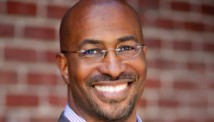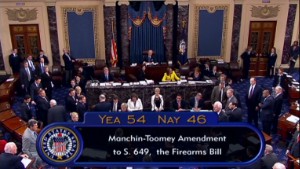Editor's note: Van Jones, a CNN contributor, is president and founder of Rebuild the Dream, an online platform focusing on policy, economics and media. He was President Barack Obama's green jobs adviser in 2009. He is also founder of Green for All, a national organization working to build a green economy. Follow him on Twitter: @VanJones68.
(CNN) -- Richard Biennestin was only 20 years old when he was shot and killed on April 13. Jessie Leon Jordan was 23. Sione Fakatoufifita was 19. Titania Mitchell was only 13. Of the nearly two dozen people reported killed that day, about half were under age 30.
Sadly, this tally is not rare.
According to the Children's Defense Fund, guns kill twice as many kids as cancer while Congress remains stalemated. A bill to pass gun reforms failed in the Senate on Wednesday. As CNN has reported, 13 young people between ages 10 and 24 are the victims of homicide every single day. Firearms account for 80% of those deaths.
 Van Jones
Van Jones The toll gun violence is taking on young people was the inspiration for GunShowGallery.com, a collaboration between the Creative Action Network and my organization, Rebuild the Dream. More than 70 artists have submitted 111 poster designs against gun violence. Most of these artists are in their 20s.
You do not have to agree with the message of each individual poster. Collectively, they represent the diverse voices of a generation desperate to stop the violence devastating its members. In poll after poll, large numbers of Americans age 18-30 support gun reform measures.
It is worth listening to what the young people who submitted these posters are trying to say.
Become a fan of CNNOpinion Stay up to date on the latest opinion, analysis and conversations through social media. Join us at Facebook/CNNOpinion and follow us @CNNOpinion on Twitter. We welcome your ideas and comments.Alyssa Winans, a 23-year-old from Providence, Rhode Island, submitted "A Farewell to Arms." She says people are desensitized to the violence. "It is simply how it is, how it has always been. This is what guns are like." She grew up outside Chicago and recalls one of her older sisters coming home from school in the city with terrifying news: "My classmate got shot and they're dead." It left a lasting impression on her.
J.D. Reeves, 25, was around guns while growing up in rural Oklahoma. Guns were for hunting. They were not something bad or dangerous, simply a part of life. But a personal experience last spring led to his piece, "End Gun Culture in America." Reeves and his wife were considering going to watch the Oklahoma Thunder NBA playoffs game in Oklahoma City, but decided against it at the last minute.
That night, gunfire broke out near the arena. Eight people were wounded. "I always heard about shootings in cities but never felt a connection because I live in the country," Reeves says. "That made it real. We could have been there. I have friends who were there. They have video of it on their phones."
Ryan Keller, from Iowa, sent in a piece called "Dissolve the Targets." Though he supports restrictions on guns, he has a big problem with violence in the media, especially the video game industry. Young people, he says, "need to see that violence in general is absolutely horrific. They need to see humans as humans, not something you can kill and get 100 points."
Juana Medina lives in Washington, but grew up in war-torn Colombia. She recalls seeing people threatened and killed. Her aunt and uncle met while taking cover under a table at a restaurant during a gunfight. Her poster, "Less Fear, More Kindness," aims to confront the culture of fear she saw in Colombia and sees today in cities around America.
Can their posters make a dent in a debate dominated by the NRA's army of lobbyists?
 Gun control amendment fails in Senate
Gun control amendment fails in Senate They think so. "We live in a culture of short attention spans and high consumption," Medina says. "As artists we create striking images that even if you see for only two or three seconds can change minds."
Max Slavkin co-founded the Creative Action Network with longtime friend Aaron Perry-Zucker. After Newtown, artists started asking what they could do to help. "Older generations accept that this is how the game is played, the need to wait for Congress, that leaders can't go too far," Slavkin says. "But younger people have seen failure after failure -- on the financial crisis, the environment and guns. We're too fired up to wait or sign petitions that we just haven't seen working."
Perry-Zucker, the creator of 2008's Design for Obama, believes that art and culture can simulate the kind of personal experience that gets people involved. "Seeing one of these posters forces you to take a stance," he notes. "You can't help but decide if you agree, or if you see it differently. And now you are more involved." Or, as Allyssa Winans puts it, artists can pose a simple question: "What if it wasn't like this?"
J.D. Reeves recalls a story in an Oklahoma paper about a known felon buying a firearm at a gun show while the local police stood by, helpless. "If you're smart with guns and people are around guns they aren't necessarily bad. But seeing this story you realize something has to change for our safety as Americans."
Idealistic, yet practical. Always experimenting with new ideas. Determined to change the world. I cannot wait for the best of this next generation to take over.
Follow @CNNOpinion on Twitter.
Join us at Facebook/CNNOpinion.
{ 0 comments... read them below or add one }
Post a Comment